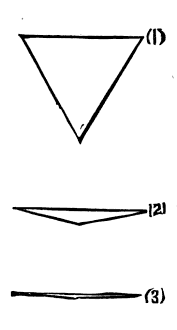Flatland
by Edwin A. Abbott
Part 1, This World, Section 1: Of the Nature of Flatland
Additional Information
- Year Published: 1885
- Language: English
- Country of Origin: England
- Source: Abbott, E. A. (1885). Flatland.Boston, MA: Roberts Brothers.
-
Readability:
- Flesch–Kincaid Level: 12.0
- Word Count: 461
- Genre: Fantasy
- Keywords: geometry
- ✎ Cite This
Downloads
PART 1.
THIS WORLD.
"Be patient, for the world is broad and wide."
Section 1: Of the Nature of Flatland.
Imagine a vast sheet of paper on which straight Lines, Triangles, Squares, Pentagons, Hexagons, and other figures, instead of remaining fixed in their places, move freely about, on or in the surface, but without the power of rising above or sinking below it, very much like shadows — only hard with luminous edges — and you will then have a pretty correct notion of my country and countrymen. Alas, a few years ago, I should have said "my universe": but now my mind has been opened to higher views of things.

Place a penny on the middle of one of your tables in Space; and leaning over it, look down upon it. It will appear a circle.
The same thing would happen if you were to treat in the same way a Triangle, or a Square, or any other figure cut out from pasteboard. As soon as you look at it with your eye on the edge of the table, you will find that it ceases to appear to you as a figure, and that it becomes in appearance a straight line. Take for example an equilateral Triangle — who represents with us a Tradesman of the respectable class. Figure 1 represents the Tradesman as you would see him while you were bending over him from above; figures 2 and 3 represent the Tradesman, as you would see him if your eye were close to the level, or all but on the level of the table; and if your eye were quite on the level of the table (and that is how we see him in Flatland) you would see nothing but a straight line.
Well, that is just what we see when one of our triangular or other acquaintances comes towards us in Flatland. As there is neither sun with us, nor any light of such a kind as to make shadows, we have none of the helps to the sight that you have in Spaceland. If our friend comes closer to us we see his line becomes larger; if he leaves us it becomes smaller; but still he looks like a straight line; be he a Triangle, Square, Pentagon, Hexagon, Circle, what you will — a straight Line he looks and nothing else.
You may perhaps ask how under these disadvantages circumstances we are able to distinguish our friends from one another: but the answer to this very natural question will be more fitly and easily given when I come to describe the inhabitants of Flatland. For the present let me defer this subject, and say a word or two about the climate and houses in our country.